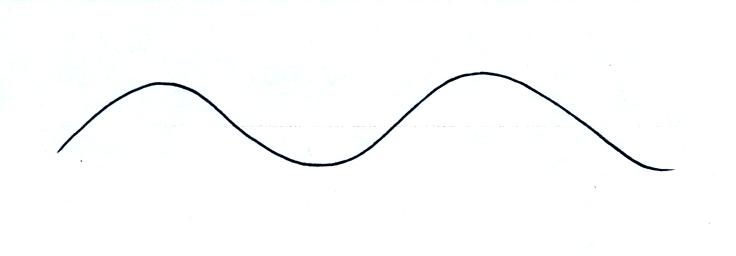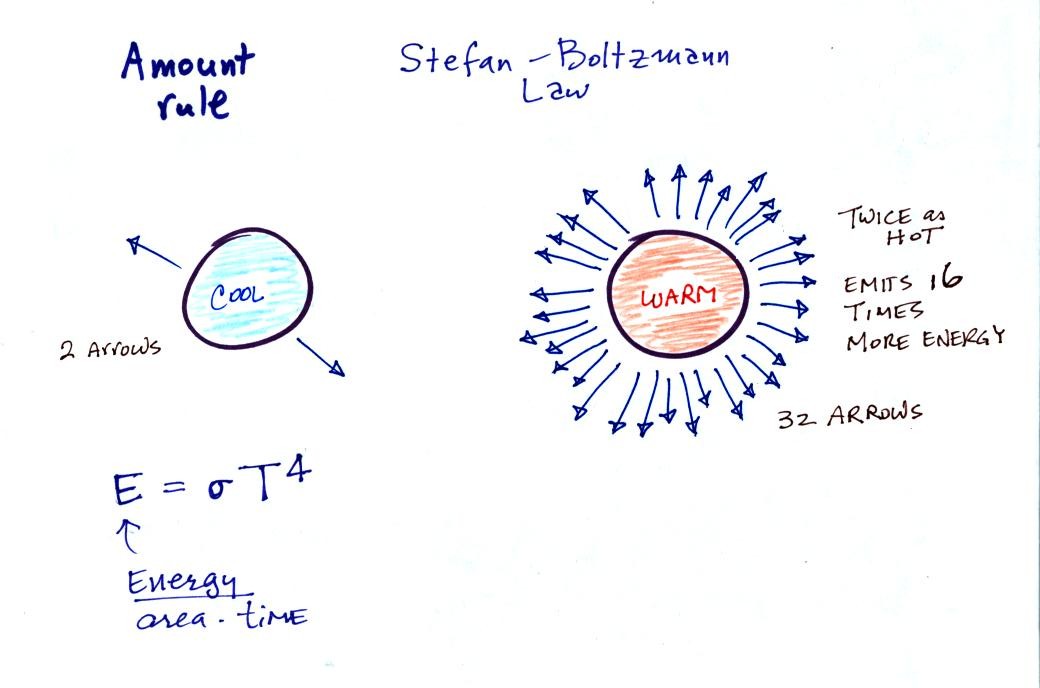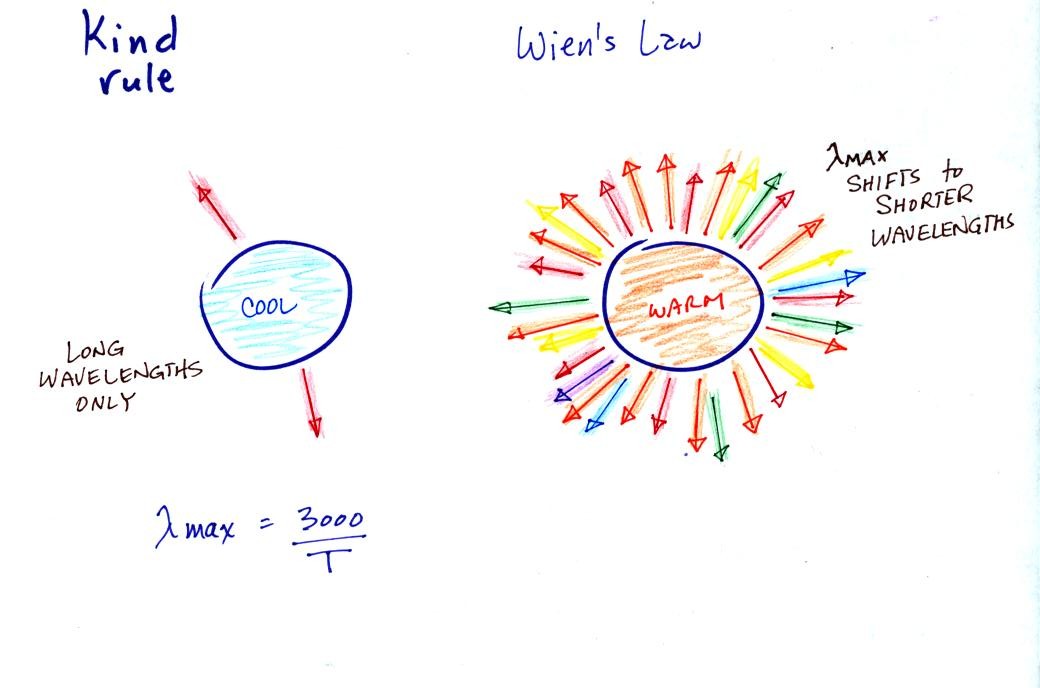To gain any understanding of EM radiation you need to understand
something about electric
fields. To understand electric fields we need to quickly review a
basic rule concerning static electricity that we mentioned in our
discussion about lightning.

The rule is illustrated above.
Now imagine, as shown below, placing a + charge at three different
positions (a, b, & c) around another center charge.

Each of the charges is going to be repelled by the center charge.
The charge at (a) will be pushed to the left with a fairly strong force
(because it is closest to the center charge). The charge at (c)
is further from the center and will be pushed to the upper right with a
weak force. Charge (b) will pushed to the right with medium
strength force. These various forces are shown on the next figure.

With just a little thought you can see that if you were to place +
charges at other positions you would eventually end up with a pattern
as shown below.

This is the pattern of the electric field vectors or arrows around a
center + charge. The arrows tell you the direction and strength
of the force that would be exerted on a second + charge placed anywhere
is the figure. The electric field illustrated here is known as a
static field because the center charge is not moving.
We will use similar electric field arrows to
understand the behavior of electromagnetic radiation.

We imagine turning on a source of EM radiation and then a
short time
later we take a snapshot. During this time the EM radiation has
propagated off to the right. If you could see the radiation you
would see a wavy pattern of
electric and magnetic field arrows. We'll ignore the magnetic
field lines. The E field lines sometimes point up, sometimes
down. The pattern of electric field arrows repeats itself.
Note the + charge near the right side of the picture. At the time
this
picture was taken the electric field arrow at the position of the +
charge indicates that the radiation is exerting a strong upward force
on the charge.

Textbooks often represent EM radiation with a wavy line like
shown
above. The first snapshot figure above shows us what this wavy
line really represents.

The wavy line just connects the tips of a bunch of electric
field
arrows.
Now we
take another snapshot a short time later. The wavy pattern has
moved to the right.

The EM radiation now
exerts a relatively weak downward force on the + charge.
And finally one more snapshot.

The + charge is now being pushed upward again. A movie
of
the +
charge, rather than just a series of snapshots, would show the charge
bobbing up and down much like a swimmer in the
ocean would do as waves passed by.

The wavy pattern used to
depict EM radiation can be described spatially in terms of its
wavelength,
the distance between identical points on the pattern. By
spatially we mean you look at different parts of the radiation at one
particular time.

Or you can
describe the radiation temporally
using the frequency of oscillation
(number of up and down cycles completed by an oscillating charge per
second). By temporally we mean you at one particular point for a
period of time.
One way of
producing EM radiation is to move an electrical charge up and down.

You add energy when you cause an electrical charge to move up and down
and create the EM radiation (top).
In the middle figure, the EM
radiation then travels out
to the
right (it could be through empty space or through something like the
atmosphere).
Once
the EM radiation encounters an electrical charge at another location
(bottom right),
the energy reappears as the radiation causes the charge to move.
Energy
has been transported from left to right.
 EM radiation is created
when you cause a charge to move up and down.
If you move a charge up and down slowly (upper left in the
figure above) you would produce long wavelength radiation that would
propagate out to the right at the speed of light. If you move the
charge up and down more rapidly you produce short wavelength radiation
that propagates at the same speed.
EM radiation is created
when you cause a charge to move up and down.
If you move a charge up and down slowly (upper left in the
figure above) you would produce long wavelength radiation that would
propagate out to the right at the speed of light. If you move the
charge up and down more rapidly you produce short wavelength radiation
that propagates at the same speed.
Once the EM radiation encounters the charges at the right side of the
figure above the EM radiation causes those charges to oscillate up and
down. In the case of the long wavelength radiation the charge at
right oscillates slowly. This is low frequency and low energy
motion. The short wavelength causes the charge at right to
oscillate more rapidly - high frequency and high energy.
The characteristics long wavelength - low frequency - low energy go
together. So do short wavelength - high frequency - high energy.
Note that the two different types of radiation both propagate at the
same speed.

This is really just a partial list of some of the different
types of EM
radiation. In the top list, shortwave length and high energy
forms of EM radiation are on the left (gamma rays and X-rays for
example). Microwaves and radiowaves are longer wavelength, lower
energy forms of EM radiation.
We will mostly be concerned with just ultraviolet light (UV), visible
light (VIS), and infrared light (IR). Note the micrometer
(millionths of a meter) units used for wavelength. The visible
portion of the spectrum falls between 0.4 and 0.7 micrometers (UV and
IR light are both invisible). All of the vivid colors shown above
are just EM radiation with slightly different wavelengths. WHen
you see all of these colors mixed together, you see white light.

1.
Unless an object is very cold (0
K) it will emit EM
radiation. All the people, the furniture, the walls and the floor
in the classroom are emitting EM radiation. Often this radiation
will be invisible so that we can't see it and weak enough that we can't
feel it. Both the amount and kind (wavelength) of the emitted
radiation depend on the object's temperature.
2.
The second rule allows you to
determine the amount of EM radiation (radiant energy) an object will
emit. Don't worry about the units,
you can think of this as amount, or rate, or intensity.
Don't worry about σ either, it is just a
constant. The amount depends on temperature to
the fourth
power. If the temperature of an object doubles the amount of
energy emitted will increase by a factor of 2 to the 4th power
(that's 2 x 2 x 2 x 2 = 16). A hot object just doesn't emit a
little more energy than a
cold object it emits a lot more energy than a cold object. This
is illustrated in the following figure:

3.
The third rule tells you something
about the kind of radiation emitted
by an object. We will see that objects usually emit radiation at
many different wavelengths. There is one wavelength however at
which the object emits more energy than at any other wavelength.
This is called lambda max (lambda is the greek character used to
represent wavelength) and is called the wavelength of maximum
emission. The third rule allows
you to calculate "lambda max." This is illustrated below:

The graph below
also helps to illustrate the Stefan-Boltzmann
law and Wien's law, particularly the meaning of lambda max.

Notice first that both and warm and the cold objects emit
radiation
over a range of wavelengths. In some respects this is like quiz
grades. Not everyone in the room gets the same score; there's
usually a very wide range of scores. Objects do emit more of one
particular wavelength than any other wavelength. This is lambda
max.
The area under the warm object curve is much bigger than the area under
the cold object curve. The area under the curve is a measure of
the total radiant energy emitted by the object. This illustrates
the fact that the warmer object emits a lot more radiant energy than
the colder object.
Lambda max has shifted toward shorter wavelengths for the warmer
object. This is Wien's law in action. The warmer object is
emitting a lot of short wavelength radiation that the colder object
doesn't emit.












 EM radiation is created
when you cause a charge to move up and down.
If you move a charge up and down slowly (upper left in the
figure above) you would produce long wavelength radiation that would
propagate out to the right at the speed of light. If you move the
charge up and down more rapidly you produce short wavelength radiation
that propagates at the same speed.
EM radiation is created
when you cause a charge to move up and down.
If you move a charge up and down slowly (upper left in the
figure above) you would produce long wavelength radiation that would
propagate out to the right at the speed of light. If you move the
charge up and down more rapidly you produce short wavelength radiation
that propagates at the same speed.



